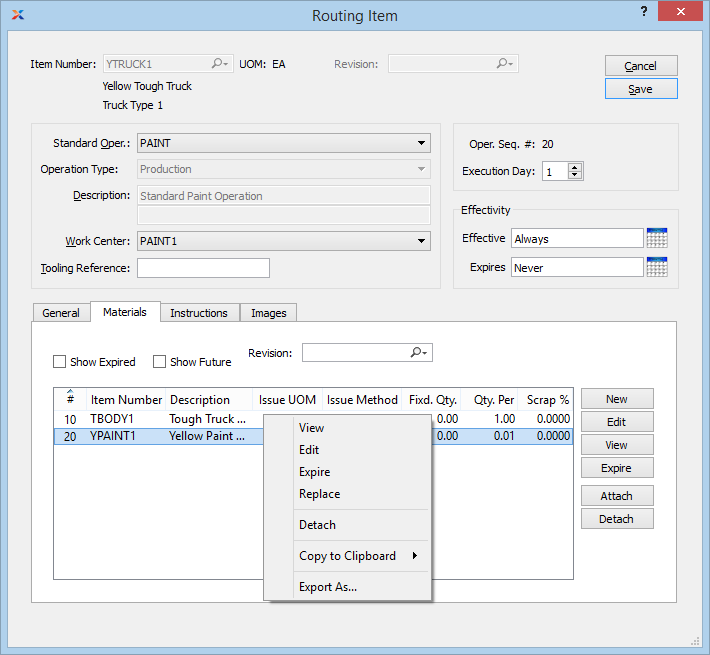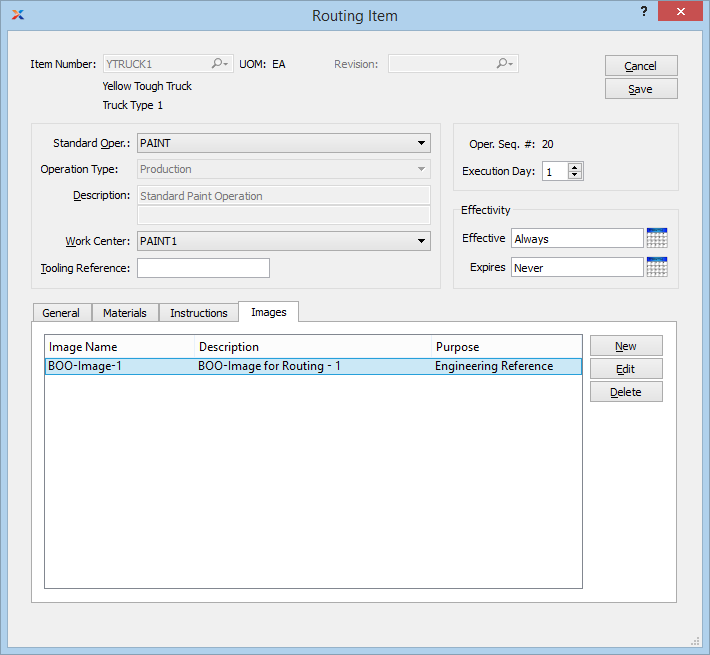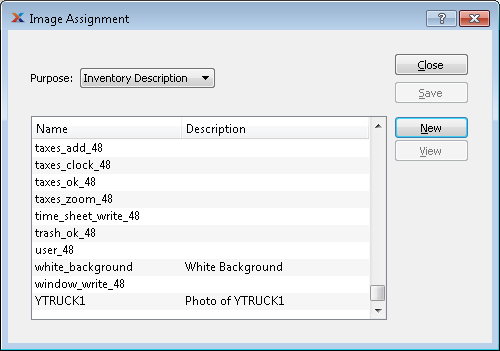
|
xTuple ERP Reference Guide |
To add a new operation to a routing, select the button. The following screen will appear:

When adding a new operation to a routing, you are presented with the following options:
Displays item number specified in Routing screen.
Inventory unit of measure (UOM).
Select a standard operation to use for the operation, if any. Instructions associated with the standard operation will be displayed below.
If a standard operation is specified, the operation type associated with the standard operation will be displayed.
Enter a description to further identify the operation.
Specify work center to be used for the specified operation.
Use this field to briefly describe any tooling required for the operation. For example, if you are making plastic products, the tooling reference might refer to the mold used to form the plastic.
Displays operation sequence number.
Select a number using the arrows, or manually enter a value up to a maximum of 99. This feature enables you to schedule work order materials with work order operations. For example, let's say we have an operation with an execution day = 5. This means the operation is scheduled to begin five days after the start date of the work order. Components scheduled with this operation are due the day before the operation starts—that is, on day four after the work order start date—to ensure they will be available when the operation is scheduled to begin. If this option is not selected, then the component scheduling will be governed by the start and due dates set on the work order header. Based on the values entered for all listed operations, whichever execution day value is the maximum, that value will be displayed as the production lead time for the routing.
Specify the operation's effectivity, using the following parameters:
The system enables you to specify when an operation can be used in a bill of materials (BOM). For example, the company's engineering department may be working on a new design for an existing item—but that new design will not be available for use until a given date in the future. In this case, you can specify the effective date when the component will be available for use.
The system also enables you to specify when an operation is planned to be obsoleted from (i.e., no longer used in) a BOM. As mentioned above, the company's engineering department may be working on a new design for an existing item—but that new design will not be available for use until a given date in the future. In this case, the old component item must be marked for expiration on a given date. This expiration date will most likely coincide with the effective date of the replacement part. Setting this parameter will instruct the system to stop using the specified component on the date entered into this field.
Standard operations are intended as initial templates used to set up routing items. Any changes made to a standard operation will not automatically ripple throughout all your routing items that use the standard operation.
Amount entered represents the number of minutes required to set up the work center for the operation.
Specify whether you want to report setup costs as , , or . Specify the option if you would do not want to track setup time as part of the operation's cost.
Select to report setup time. Must be selected for labor costs associated with setup to be tracked in the G/L and elsewhere. If not selected, these costs will not be reported.
Amount entered represents the number of minutes required to run the production UOM.
Specify whether you want to report setup costs as , , or . Specify the option if you would do not want to track setup time as part of the operation's cost.
Select to report run time. Must be selected for labor costs associated with run time to be tracked in the G/L and elsewhere. If not selected, these costs will not be reported.
When operations are posted, inventory transaction records will be posted to the general ledger if at least one of the operations in the list of work order operations has either or both of the inventory handling options selected. If items are backflushed at an operation, select the Auto. Issue Components option. If finished items are received into inventory at an operation, select the Receive Inventory option.
Specify the standard quantity that will be produced during a typical run-time period. The value entered here is equivalent to a run size, batch size, or economic order quantity (EOQ) for this particular operation. Because work order operations roll into the actual and standard costs for manufactured items, you should specify a per quantity which accurately reflects your normal batch size for the operation. Specifying a standard batch size helps ensure your operations costs are evenly distributed. The following equation indicates how operations costs are distributed using batch sizes:
The following table illustrates two examples of how differing batch sizes produce different operations costs per unit:
Table 1.1. Example Batch Sizes with Operations Costing
Setup Time (Mins) | Run Time (Mins) | Units in Run ("per") | Setup Cost from WC (Per Min) | Run Cost from WC (Per Min) | Extended Cost per Unit |
|---|---|---|---|---|---|
15 | 100 | 10 | $0.500 | $0.417 | $4.920 |
15 | 1000 | 100 | $0.500 | $0.417 | $4.245 |
Select a UOM—or enter a free-form UOM. Specify a UOM to be used optionally when work order operations are posted for the specified operation. Different operations in a single routing may use different production UOMs. For example, if you are producing soup, you might mix the soup in one operation using UOM = BATCH. But when canning the soup, the canning operation might use UOM = CAN.
When posting work order operations, you are given the option to post operations using production UOMs or inventory UOMs.
This is the ratio that normalizes quantities to create a production UOM for use when posting work order operations.
Select to indicate that the manufactured item should be received into inventory at this operation. The manufactured item will be received into inventory via a receive from manufacturing (RM) transaction, when the operation is posted.
The Receive Inventory at this Operation option may only be selected once per routing. Finished items may only be received into inventory once in the operations sequence.
Issue components at this operation: Select to automatically issue components used at this operation. This setting will only affect component items whose issue method is either pull or mixed. Component items using the push issue method must be issued to work orders using a specific material issue transaction.
Select to allow the operation to overlap with the preceding operation. If selected, you are indicating that this operation may be posted before the preceding operation is complete. If not selected, the operation may not be posted before the preceding operation is complete.
Select a work-in-process (WIP) location. This is an optional selection which may be used for tracking the site locations of finished goods inventory as it moves through the manufacturing process. The feature applies only to top-level, multiple location control (MLC) items whose production is posted through work order operations posting. If you choose to track finished MLC goods using this feature, then the WIP location entered here is the location where inventory will be located when the preceding operation for the work order is posted. A proceeding operation must exist for the location entered here to be used. If you do not wish to track WIP locations for finished MLC goods, then you can ignore this option.
Indicates the number of units, in the given item's inventory UOM, that can be produced in a minute—and also the number of minutes that are required to produce 1 unit, expressed in the given item's inventory UOM.
Bill of materials (BOM) items may be associated with operations—either materials, tools, or finished goods themselves. In an effort to help manage this relationship, the Operation screen includes the ability to both modify the source BOM and also modify the links between the operation and component items. To view components associated with an operation, select the tab. The following screen will appear:

When viewing components associated with an operation, you are presented with the following options:
Select to display expired components associated with the operation.
Select to display future components associated with the operation.
Specify which BOM revision you want to use in conjunction with the specified operation.
Display includes components associated with the operation.
Changes made to components on the Operation screen will be reflected in the source BOM.
The following buttons are unique to this screen:
Highlight a component and then select this button to expire the item from the BOM.
Select to associate a component with the operation.
Highlight a component and then select this button to break the link between the item and the operation.
To associate instructions with an operation, select the tab. The following screen will appear:

When associating instructions with an operation, you are presented with the following options:
This is a scrolling text field with word-wrapping for entering instructions related to the operation. If you are using a standard operation, the instructions (if any) associated with the standard operation will be displayed here. You have the option to edit these instructions, but any edits are ad hoc in nature. Edits are not saved back to the standard operation and they will be lost if you change standard operations for any reason.
Select to display text in the Instructions field in fixed-width font. This is a useful feature for displaying tables, matrixes, and other format-driven texts.
You may associate images with an operation, thereby making these images available to be printed on routings. To associate an image with an operation, select the tab. The following screen will appear:

When associating images with an operation, you are presented with the following options:
Display lists stored images available for association with the specified operation.
To specify an assignment for an image, select the NEW button. The following screen will appear:

When assigning an image to a purpose, you are presented with the following options:
Select one of the available purposes an image might serve:
Select if the image describes inventory.
Select if the image describes a product.
Select if the image serves as an engineering reference.
Select if the image is a miscellaneous image.
You may create multiple image assignments, but only one image assignment per purpose.
The following buttons are available:
Closes the screen, returning you to the previous screen.
Highlight an image, then select the button to associate the image with the specified item and purpose.
Opens screen for adding a new image to the master list of stored images.
Allows user to view image.
To add a new image to the master list of stored images, select the button. The following screen will appear:

When adding a new image to the master list of stored images, you are presented with the following options:
Enter the physical directory location of the image. The lookup feature enables you to search your system for the physical directory location of the image file. Once you locate the file, simply select it to have it entered into the File Name field.
Enter a unique name for the image.
Enter a description to further identify the image.
The following buttons are available:
Closes the screen without adding a new image to the master list of stored images.
Creates the image and adds it to the master list of stored images.
Display lists the title and URL for any files related to the item. To enter files associated with an item, select the Files option.